It was the 23rd of August and I was on vacation, staying in Port McNeill in the north part of Vancouver Island. Since vacation is a good time to do things that aren't one's normal routine, I was up early, and I had an early rendezvous. A little after six I was getting coffee and driving to Telegraph Cove to embark on a nature-watching trip put on by a little outfit known as Tide Rip Tours.
Sometime around seven I had loaded into a boat with several others and we headed eastward out of the cove towards the mainland. There had been a slight overbooking for the tour and I ended up sitting outside on the boat; this was a blessing because it meant that I could just sit and watch stuff rather than making small talk in the cabin. Maybe I missed a little information from the guides, but with my hearing and the noise of the boat, I might've missed it even if I was inside. Anyhow, I had on a loaner survival suit (with several layers of my own clothing beneath) so I was toasty warm.
Ten or fifteen minutes into our trip, we slowed down when a few Dall's Porpoises appeared off the port stern. These guys are pretty readily identifiable by their shape, the big white patch on their side, and the "rooster tails" of spray they create when they surface (seen here on the front and back ones). |
|
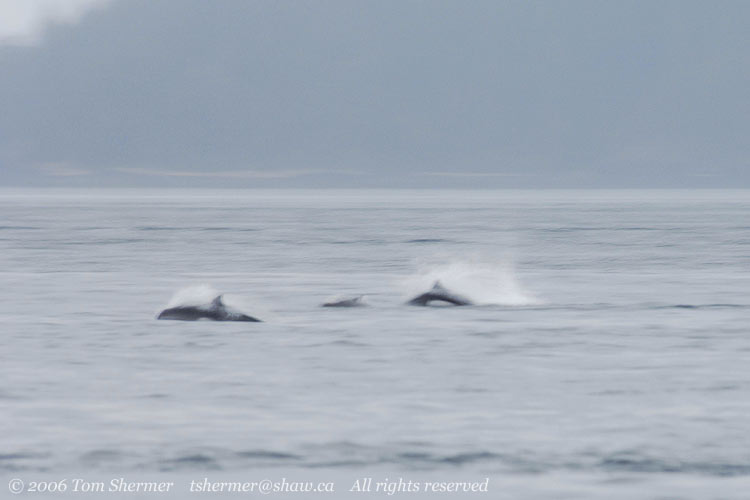 |
I'm not sure if the about the middle animal in that photo; it could be a calf or it could be the flukes of an adult. They didn't stay around long, and when they surfaced it was only briefly.
The area we were in for the day, between north Vancouver Island and the mainland, is known as the Broughton Archipelago. As one might expect in an archipelago, there were many little islands and islets all around. They made for great viewing as we motored along.
About twenty minutes after seeing the porpoises, we stopped at a small floating cabin that was moored in a sheltered inlet with absolutely no signs of civilization nearby. The folks who were staying there (it was a rental, as far as I could tell) were kayakers, and I imagined that it would be quite rewarding to paddle through the archipelago to such a place and then enjoy a comfortable little home with amenities rather than a sleeping bag on a cold rock.
As we slowed down to begin our approach to the cabin, I took the next two photos. The first shows a few little islets, looking very inviting. They were almost enough to make me want to jump in a kayak. |
|
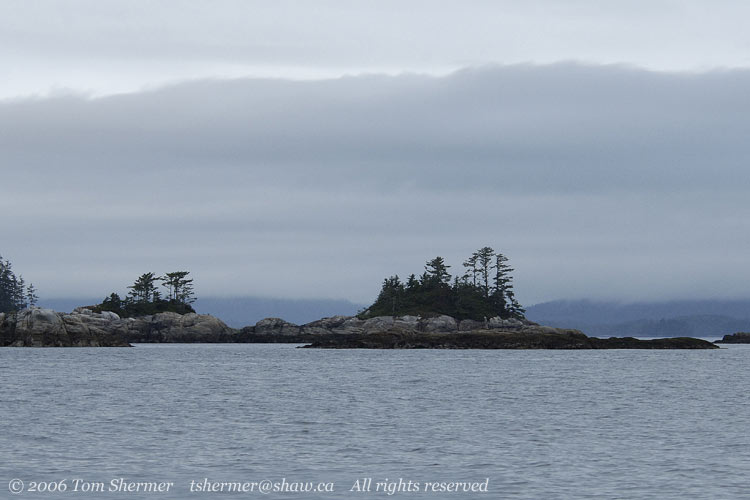 |
And the next one shows a colored rock that was colonized by gulls. There were lots of rock formations like this around, but only a few had gulls (or signs of gulls) on them. Just goes to show that gulls are pretty sociable sorts. |
|
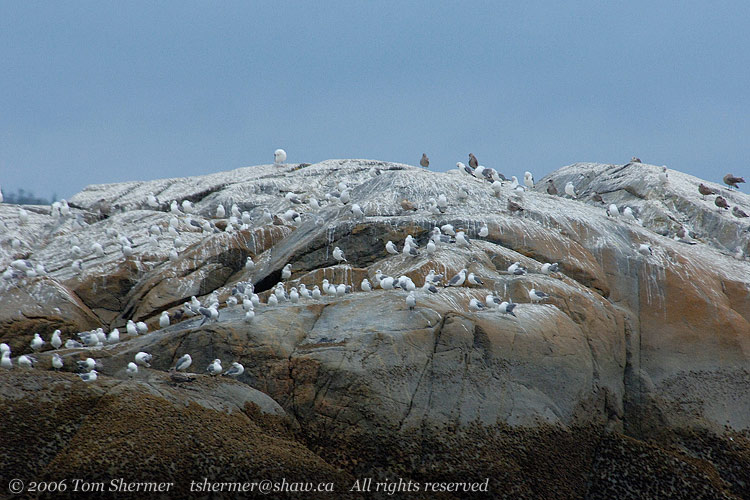 |
| We chugged off from the floating cabin, and then moved at a good rate for a half an hour or so before we slowed again. I'm not entirely sure why we slowed, but the folks inside weren't looking at anything in particular, so it wasn't some sort of nature sighting. I took advantage of the more-stable boat by taking some photos of some of the rocky sides of islands that caught my eye. |
|
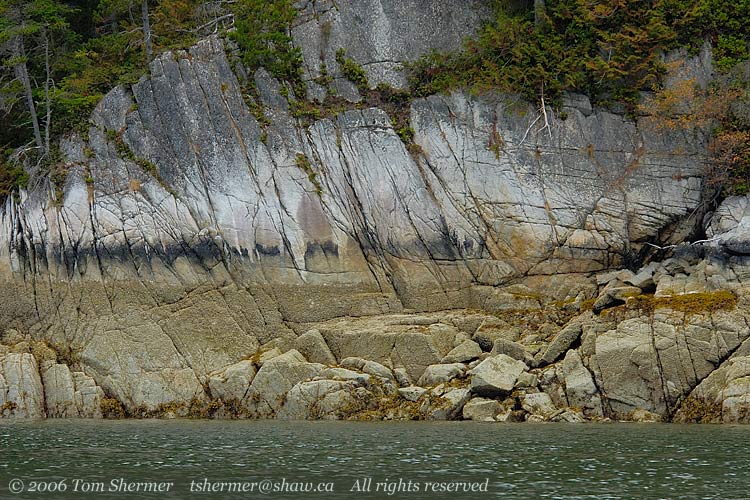 |
We only crossed wide straits a couple of times on the whole passage across to the mainland, so there were lots of rocks and islets and larger islands around. They kept me well entertained.
Just a little later, we passed one of a few fish farms that we encountered that day. |
|
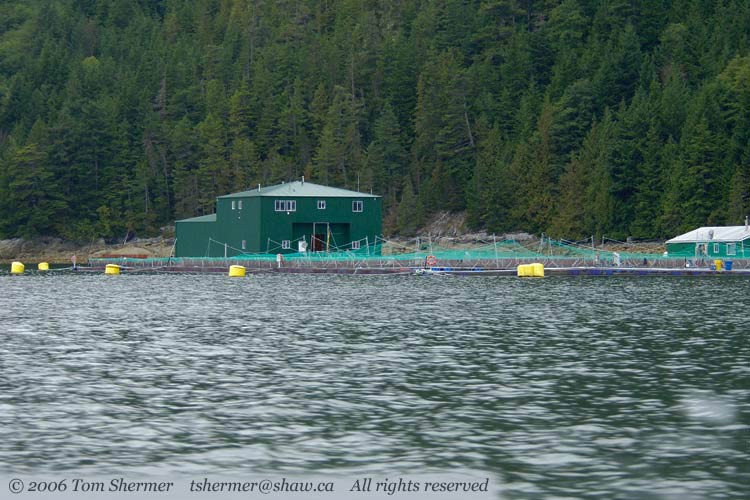 |
Fish farms in this area, most of which are salmon farms, are pretty controversial; they pose a variety of environmental and political problems. I'm not ready to call them pure evil, like many folks do, but if half of what I've heard is true they're a very serious hazard to our local ecology.
Sometime around 10 o'clock, three hours after setting out, we attained our destination: Glendale Cove, which is where the Glendale Creek meets salt water on the Knight Inlet. Once there, we switched out of the bigger boat we used for the crossing into two smaller, flatter-bottomed boats that Tide Rip keeps moored there. Here's part of our group headed in to the estuary. |
|
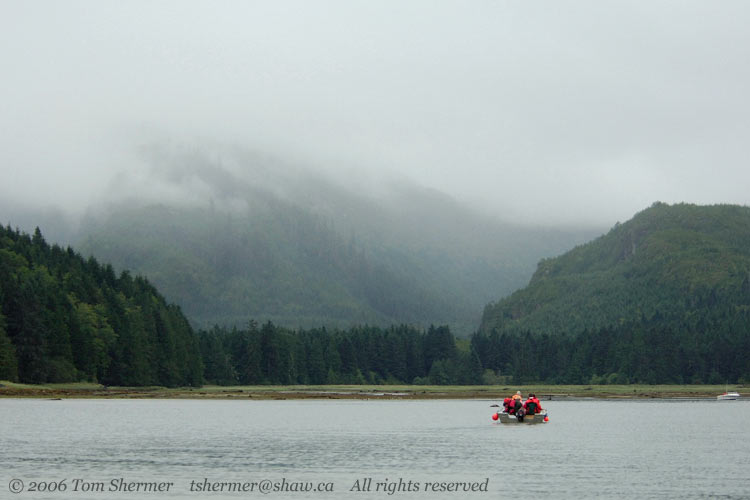 |
| Once the boat I was in got a little closer, we found a little of what we were looking for, as you can see in this next photo. |
|
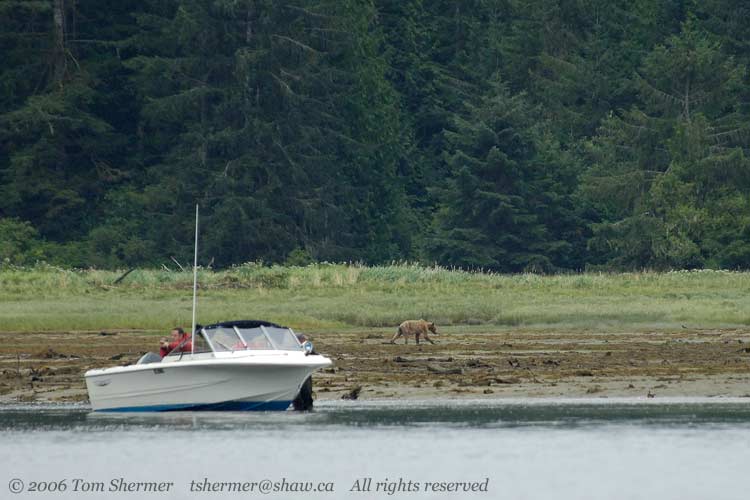 |
That poor, haggard animal in the middle of the photo is actually a bear. My guide explained that this particular bear is ill, has been losing weight for some time, and probably won't make it through another year. This area is quite well-protected, so the best estimates are that the illness is from natural causes.
Another thing about the previous photo is that it shows the general setup with boats and guides at this place. The guide for the folks in that boat is in chest waders, standing in the water near the bow of the boat. Our guide did the same. This way they can easily keep the boat in a good place without having to turn the motor on and thereby disturb the wildlife.
From my point of view, an added feature was that if a bear charged us, it would reach the guide before it reached the people in the boat. And I figured my guide was big enough to sate the hunger of even the biggest bear, so I was pretty safe.
The trundling sick bear eventually went far enough right to scare up a little flock of ducks that I hadn't previously noticed. The bear is just out of the camera frame to the left on this shot. |
|
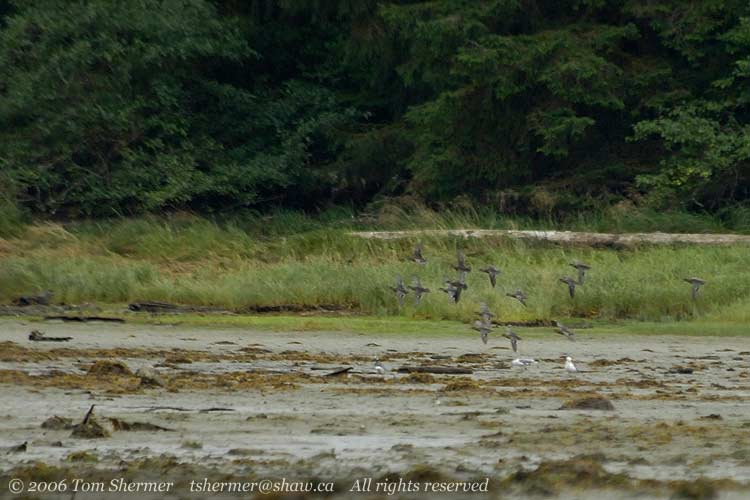 |
As near as I can tell, the ducks were Mallards. Mallards, it seems, are most everywhere.
A few minutes later, a much more proper, healthier bear made an appearance. Now you can tell that these weren't just any bears, they were Grizzly Bears. I was on a Grizzly-watching expedition. |
|
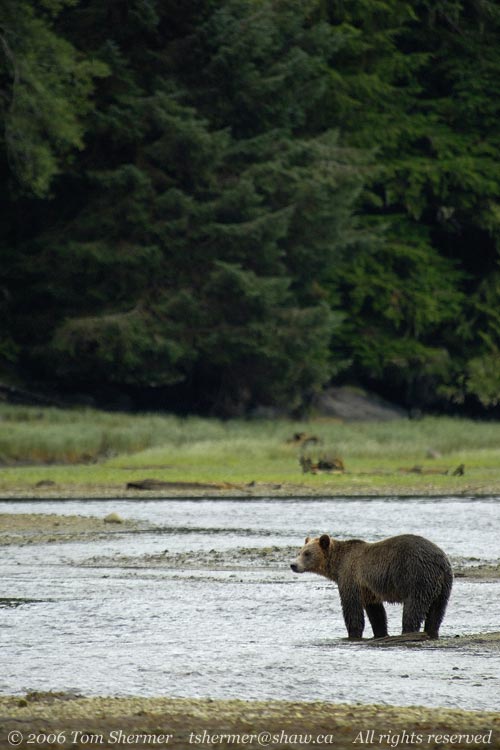 |
I checked to make sure, and yes, the guide was in the water roughly between me and the bear. I hope they pay the guides and their widows well.
The grizzly wasn't the only wildlife out and about. A Bald Eagle was standing on the other side of the boat at the edge of the mouth of the creek. |
|
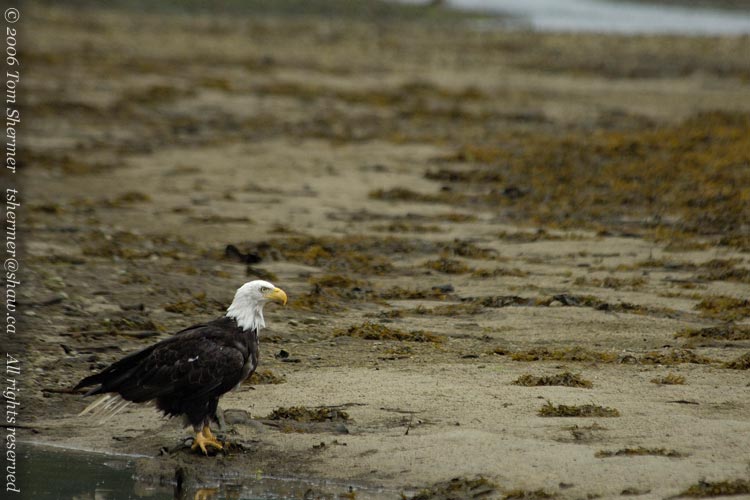 |
| It was a quarter after 10 or so, and the sun hadn't been able to break through the clouds. The clouds weren't that thick, though, so it was still bright enough out, and it wasn't raining. It was August, too, so it wasn't cold. All in all, it had turned into a great day to sit outside and enjoy nature. |
|
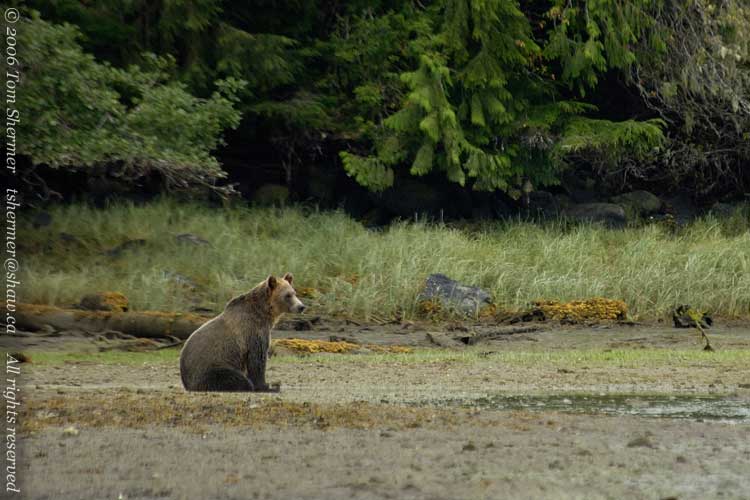 |
| As we sat and watched, a Great Blue Heron tried to sneak by. |
|
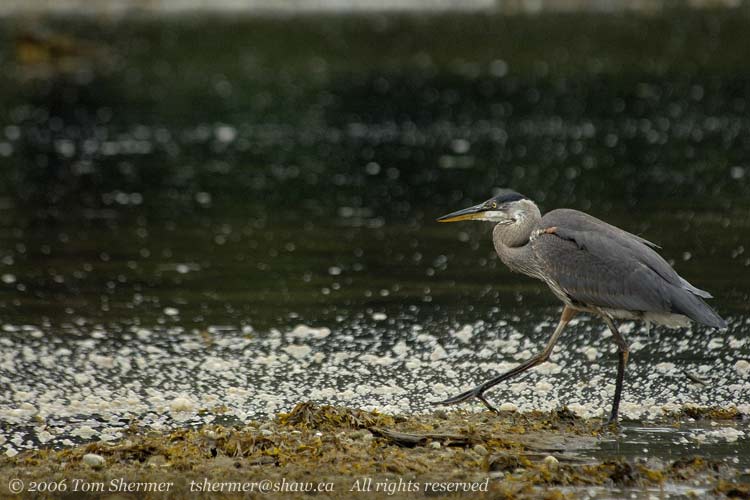 |
| And on the left (south) bank, a Black-tailed Deer made an appearance. |
|
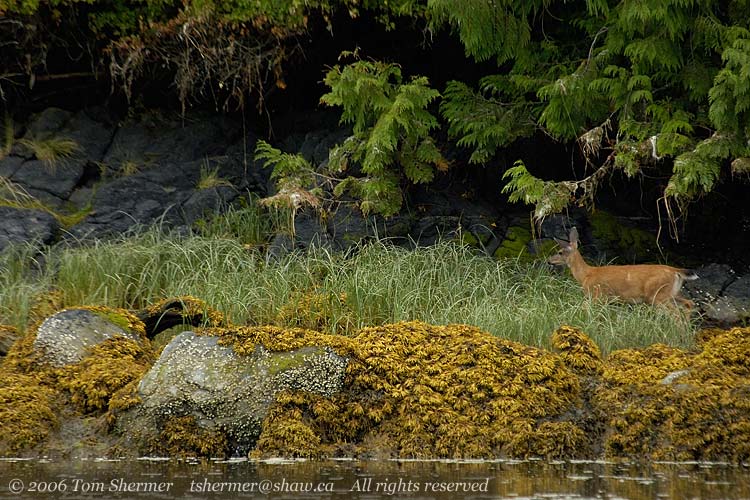 |
| The guide had floated us away from the stream mouth toward the bank, affording us great views of the deer, who wasn't as shy as many of his kind. |
|
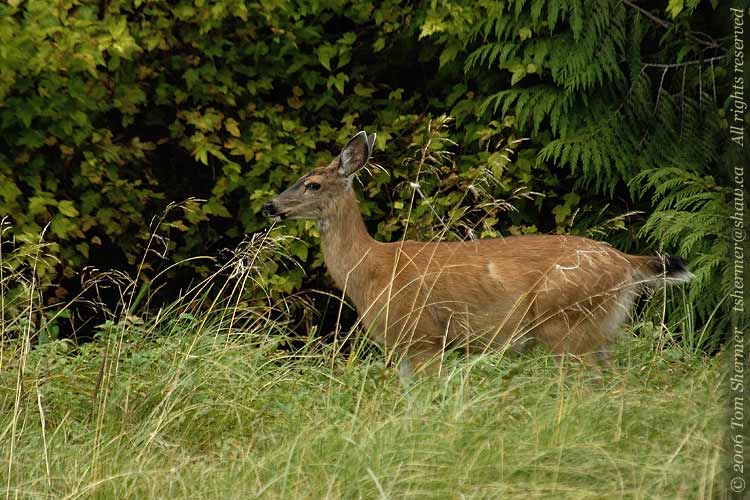 |
| Nearby were a trio of Common Mergansers, a mother (the standing one, with the longer, redder bill and less white on the face) and two children (the sitting ones). I leaned way out over the side of the boat to get this picture, just before they all launched off the log and went swimming to the right. |
|
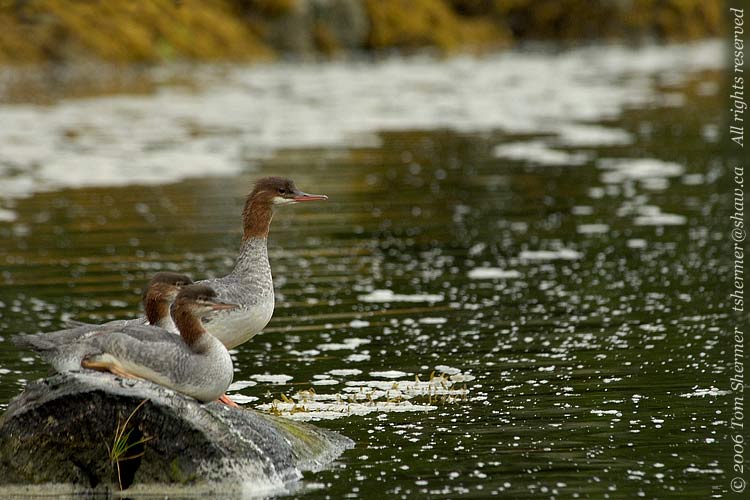 |
| Our bear had wandered off from his seat and over to the left bank, too. He was standing at the edge of some tall grass, looking around. After this, he headed further left into the woods, to do whatever it is that bears do in the woods. |
|
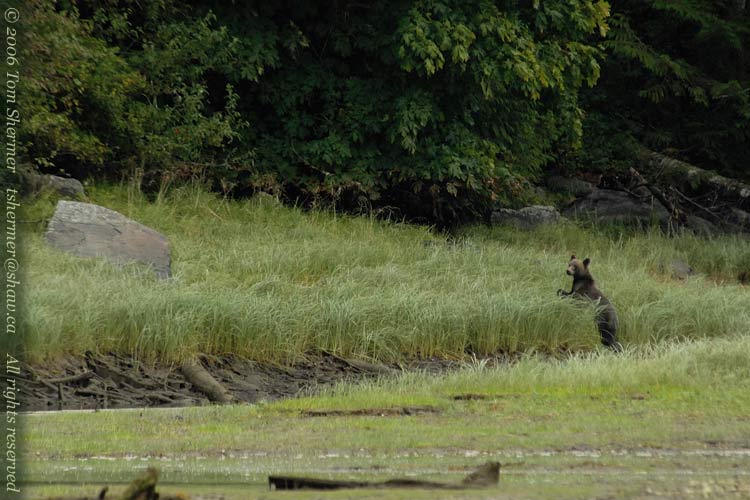 |
| We were waiting around for the tide to come in, so that we could float further up the estuary. Since there were no large mammals about, I looked for other things, and eventually found a Belted Kingfisher perched on a fallen tree above the stream. This one's a male. |
|
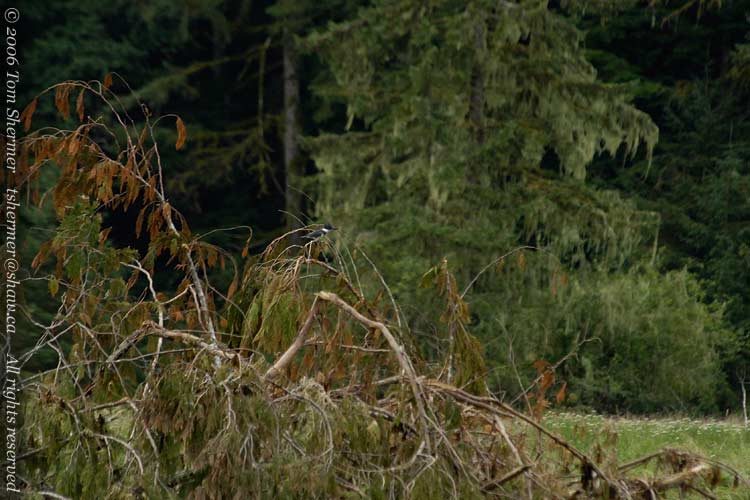 |
| By this point, it was past 11:30 and we hadn't seen any bears in a while. We started floating up the stream and ended up right beside an eagle who was perched on a streamside log. This is quite possibly the same bird as we had seen earlier. |
|
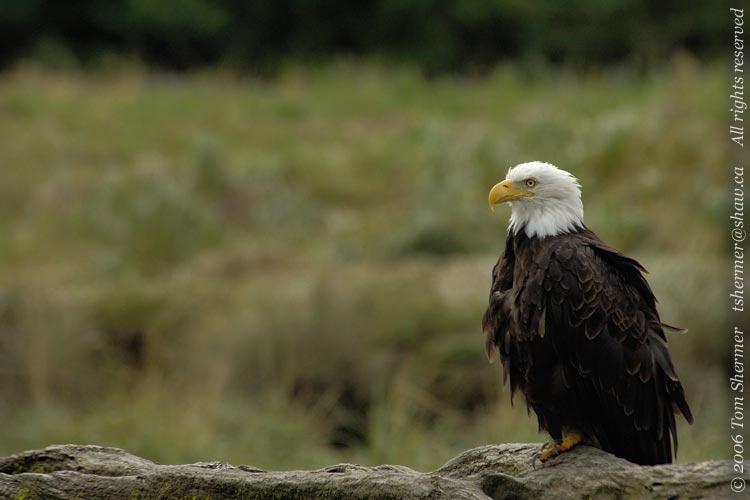 |
| We kept floating nearer and the eagle didn't seem to mind. Many birds just don't recognize floating things (like people in a boat) as being as dangerous as walking things, so one can often approach birds quite close when in a boat. |
|
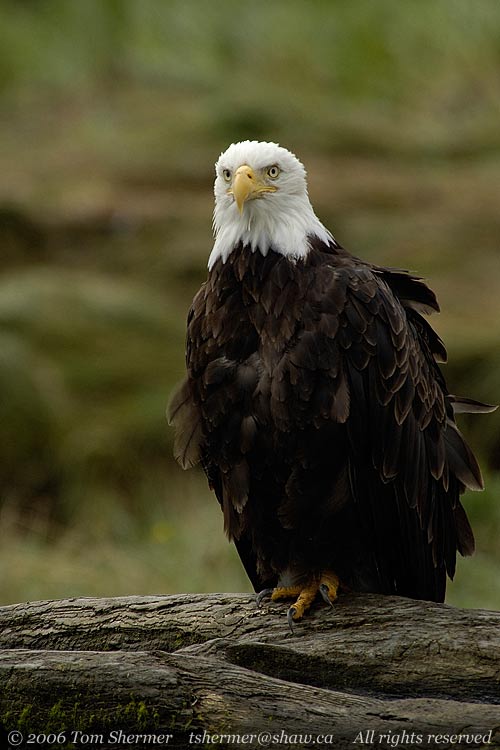 |
| One of the things that I've noted in my travels is that eagles seem to have more of a problem with earwax than other birds; I think I've mentioned it before. Anyhow, this eagle was no exception. |
|
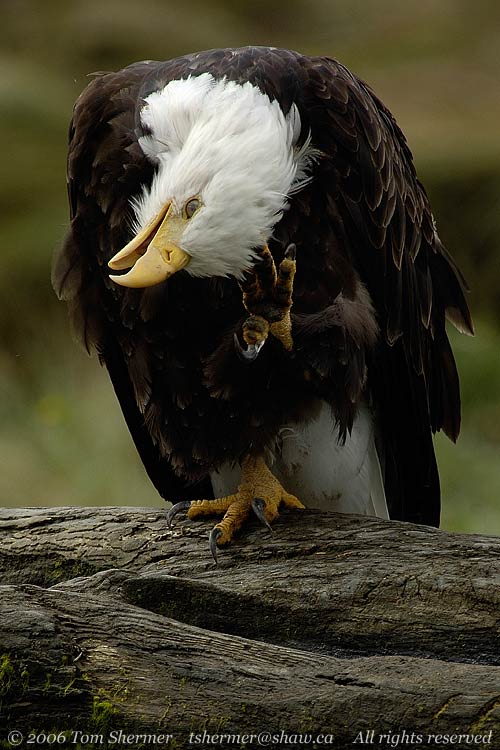 |
| Now, I'm all for getting the wax out, but I don't know if I'd risk it if my fingernails were as sharp as these babies. I like my ears in one piece, thank you. |
|
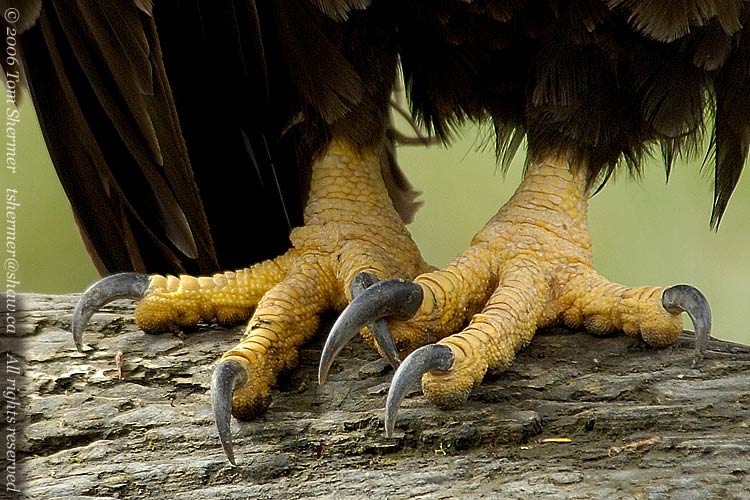 |
Then again, maybe the sharp talons actually make the process easier. After all, I can't stick my finger or even fingernail that deep into my ear. Looks like the eagle has me beat in that department.
Although it's cropped a little, that foot photo also shows just how close we were to the bird. I was certainly within three meters and maybe even within two for some of the shots. A couple of times I had to adjust my zoom lens (zooming out) to get the whole bird in the frame.
Here's one last shot of the raptor, this one with no cropping. |
|
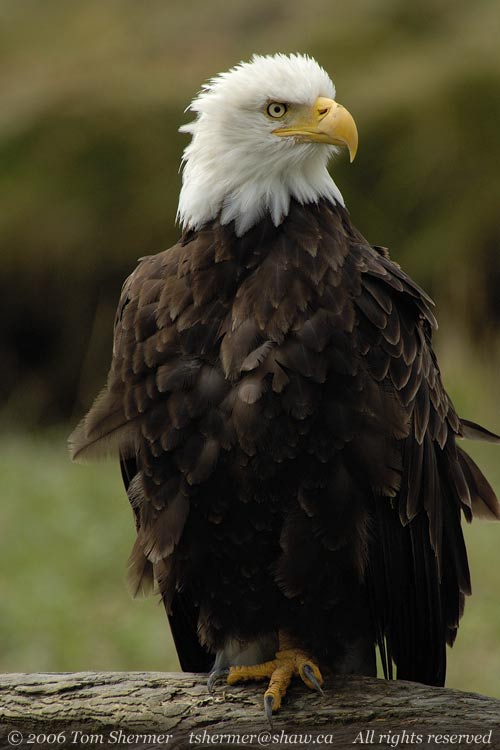 |
| That was my last shot of the bird because the guide pulled the boat along, and we saw a grizzly coming up the side of the stream towards us. |
|
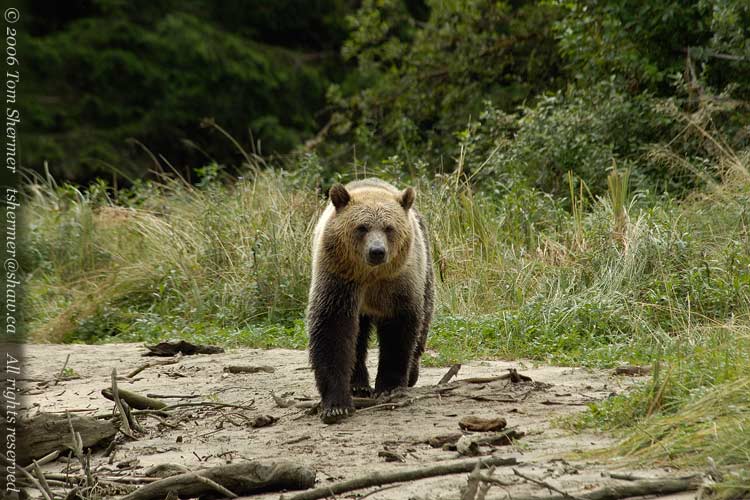 |
The bear was getting fairly close, but a quick check revealed that Tom, guide, and grizzly were in appropriate relative positions.
The bear didn't seem to bother with us, though; he turned his attention to some driftwood. |
|
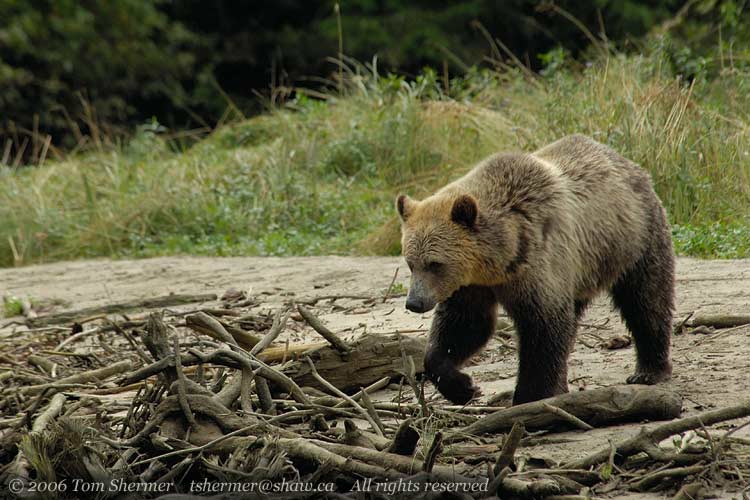 |
|
Seeing nothing of real interest there, he strolled out into the stream. |
|
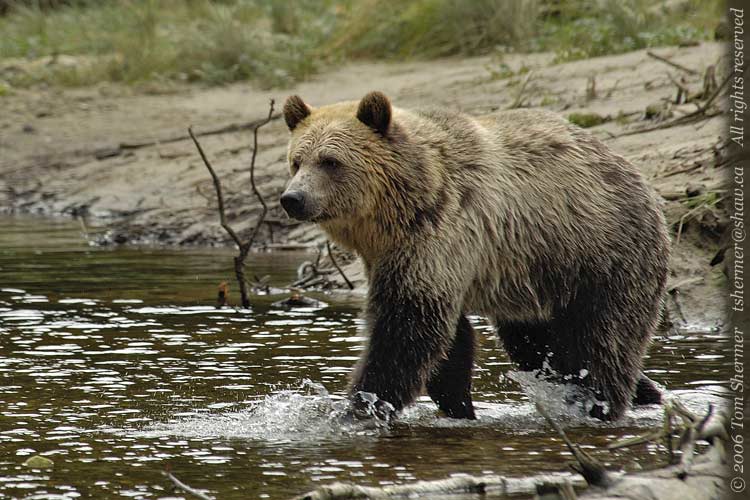 |
|
Next, he momentarily stopped and made a face at some creature or another. When you're a grizzly bear, you can stick your tongue out at anything or anyone. |
|
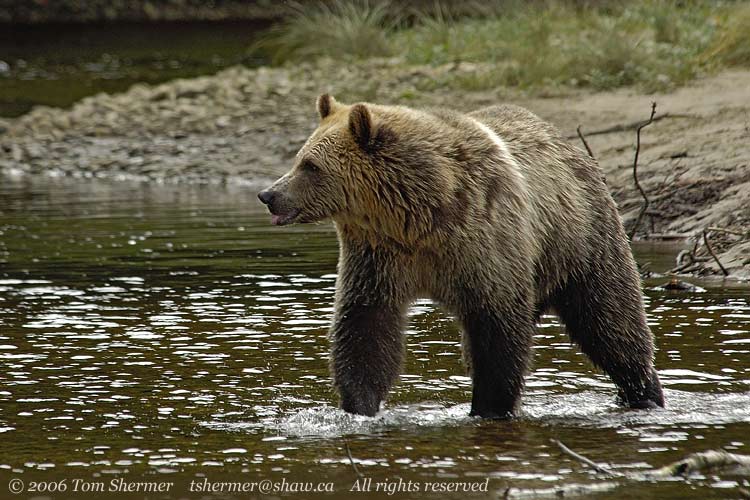 |
|
Now, just to let you know, all of these bear photos are cropped, but they aren't cropped too much: I've cut off maybe a quarter of the vertical and a quarter of the horizontal. (I.e. the originals are about 4/3 as tall and 4/3 as long.)
Anyhow, my bear walked out to the middle of the stream and stood for a while, looking pretty content. |
|
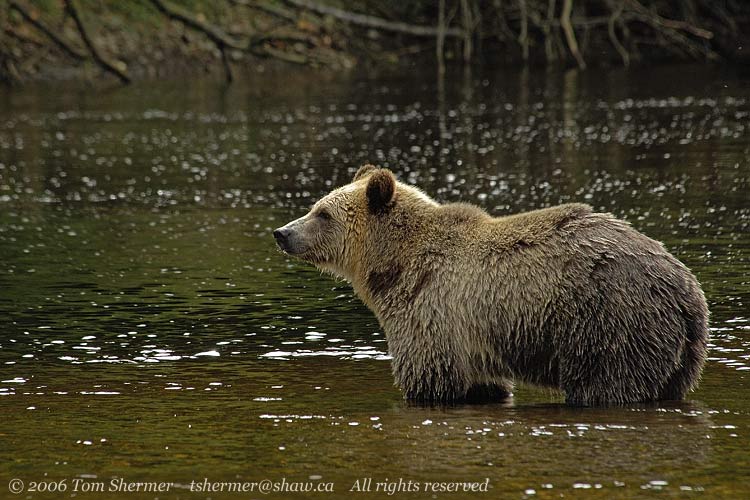 |
|
I'll stress that he walked out into the stream, not waded. This bear's motions were not like the water was impeding him or anything. Where the water would slow you or I down, it doesn't slow down the bear. Bears are that strong.
After standing in the stream for a while, the bear turned around and headed back towards the right bank. As he did, I discovered that even photographers are on the list of things that you can stick your tongue out at when you're a grizzly bear. I wasn't going to argue the point.
|
|
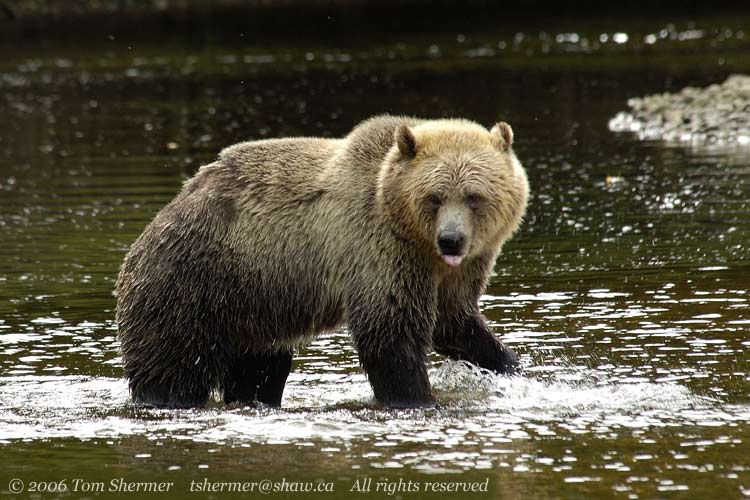 |
| Sadly, at this point, my cute little furry companion turned his tail and headed away. He gave me one good profile shot before disappearing around a bend in the stream. |
|
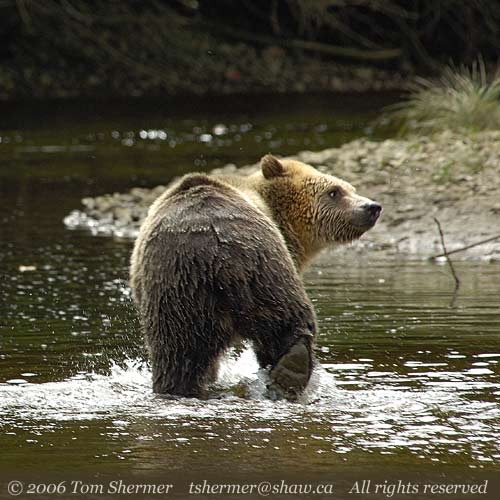 |
|
At this point it was noon, and that meant it was a good time for lunch.
There was more to my day, but since this entry has already gone on for a while, I'll end here and leave the details of lunch to the next entry.
Barely managing a closing pun,
Tom
|
|